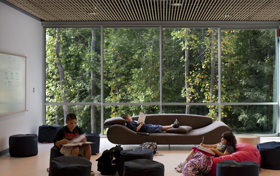Learning Opportunity
About a year ago, I toured a green school that had just reopened after a major renovation. 

A historic preservation project, the building had been restored to its original beauty and a variety of high-performance systems and technologies were incorporated.
Despite the first-rate features, the school wasn’t performing at its best in terms of energy and water use. There were no signs explaining that the daylighting strategies employed throughout the space were created to save energy and improve learning conditions. There was nothing in the bathrooms to indicated that low-flow fixtures would save thousands of gallons of water per year, and no displays acknowledged that several miles of geothermal pipes were buried under the athletic fields.
To show off the school’s new wind turbine, our tour guide had to open a locked door. Teachers and students who wished to turn off the lights in their classrooms had to track down a member of the maintenance staff to get the key.
It isn’t enough to just build green schools. As practitioners, if you design an educational facility that doesn’t impart lessons in sustainability, both actively and passively, you haven’t done your job.
As administrators, if you don’t demand a facility that outwardly demonstrates the interconnectedness between the built environment and natural systems, you are doing your teachers and students a disservice.
The greatest opportunity presented by a green school is the opportunity to utilize the facility as a teaching tool. In my experience, this is an opportunity that is frequently missed.
_0.jpg)
_0.jpg)
Planners for the LEED-registered Manassas Park Elementary School in Virginia used input from teachers, administrators and students from the projects inception.
Nothing is worse than walking into a green school that is not employing user education strategies. Children are sponges; they absorb and apply new information at an astonishing rate.
Installing educational signs that explain green strategies and systems can dramatically increase student fluency with environmental themes. I’ve met kindergarteners who can explain ground-source heat pumps simply because there are placards placed at eye level on their way out to the playground.
The top priority for educators and administrators is preparing students for life beyond the school walls. Every decision a district makes should come back to this goal, including facility design. So why do so many schools fall short when it comes to engaging students in project-based learning around topics of environmental stewardship and conservation?
The answer is simple. The architects, engineers and facility planners who are designing the projects aren’t fully collaborating with the people who will be using the space every day.
But there is a better way. Recently I visited another green school that ensures teachable moments don’t go untaught. At the LEED-registered Manassas Park Elementary School in Manassas Park, Va., educational goals were the driving force behind the green design of the new facility.
“There were really no arguments about it,” says Dr. Thomas DeBolt, superintendent of Manassas Park City Schools. Involving teachers, administrators and students from project inception to completion “just seemed like the correct thing to do not only in terms of educating kids, but also for the environment itself,” he says.
“A great teacher will tell you that there’s no such thing as a nonteachable moment,” says Wyck Knox, the lead architect for the project. “We took that on as a challenge for this school.”


Students recline in a reading area at Manassas Park Elementary.
As an example, Knox points to a green light by the door to a classroom. The light turns on when outside temperatures and humidity levels are just right. Students watch diligently for the signal and alert teachers that it’s time to open the windows and let fresh air in.
Later, Knox shows me an outdoor classroom that sits atop a rainwater-harvesting cistern; an oversized gauge indicates the amount of water available for flushing and irrigation and colorful murals show how runoff from the site will travel all the way to the Chesapeake Bay.
Principal Stacey Mamon describes participating in the planning, design and construction process as “an amazing opportunity.” Rather than telling educators to “make what you do fit into the building,” Mamon says the project architects asked “what can we do that will support and enhance the learning?”
Is the building truly enhancing the educational experience? Last year, students did better than ever on testing and, according to Mamon, during this first year of occupation she has never had a student visit her for disciplinary reasons. Though she notes that it is difficult to isolate variables for success, Mamon thinks the building has had a notable impact on the entire school population.
Green schools are different than other green buildings because they have an obligation to educate, Knox says.
“A green school can be the most energy-efficient building in the world, but if the kids graduate without learning something about that, we’ve missed an opportunity.”
Teachers at Manassas Park Elementary School are not about to let their students miss out. Mamon says her teachers will continue to develop new curriculum concepts that engage students through place-based lessons about the connections between people and planet.
“We’ve only begun to scratch the surface of what we can do to help students make positive choices for the environment,” she says.
Planners for the LEED-registered Manassas Park Elementary School in Virginia used input from teachers, administrators and students from the projects inception.
